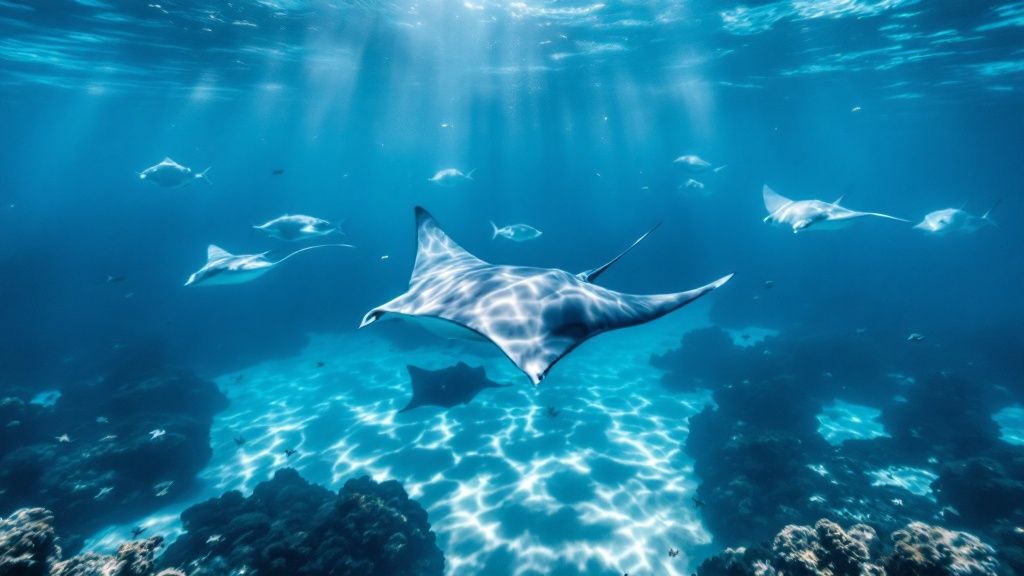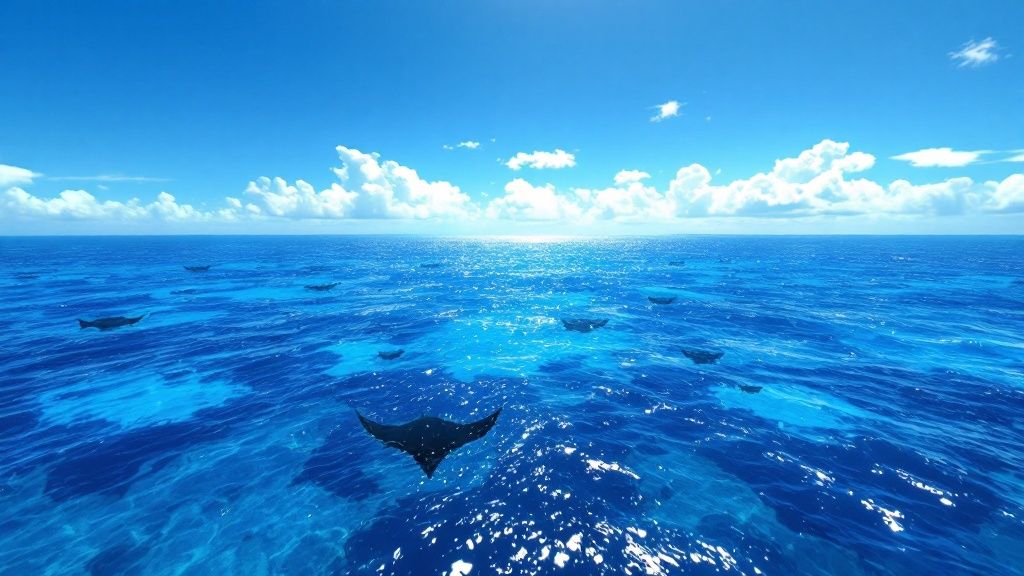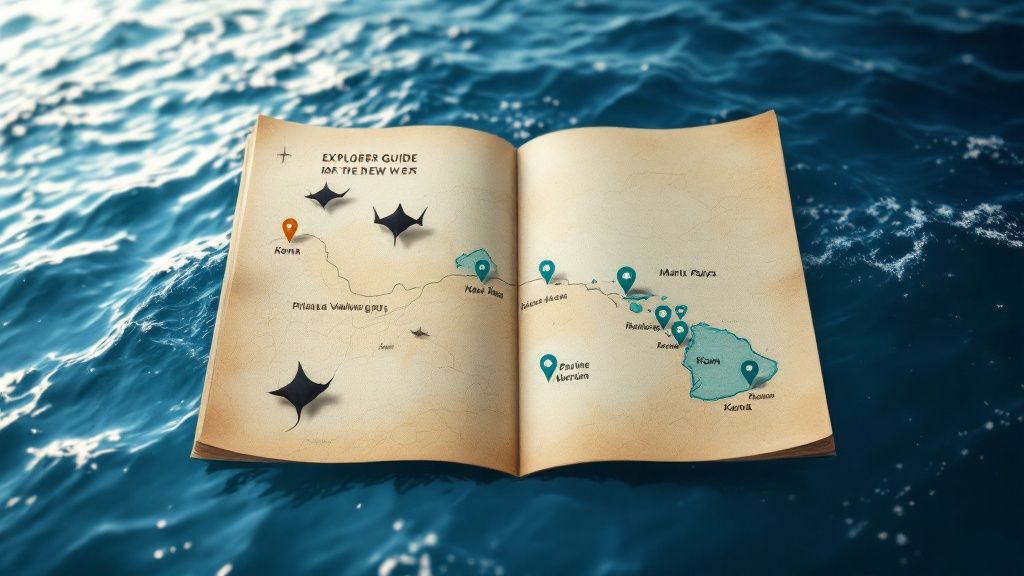Best Time to See Manta Rays in Kona: Your Ultimate Guide
- Byron
- Apr 3
- 10 min read
Why Kona's Waters Are Perfect for Manta Ray Encounters

The Kona coast of Hawaii's Big Island offers more than just scenic beauty; it's a world-renowned sanctuary for manta rays. This isn't a coincidence. The unique combination of volcanic formations and nutrient-rich ocean currents creates a perfect habitat for these gentle giants.
The volcanic rock provides shelter and essential cleaning stations. Meanwhile, the nutrient-rich currents support thriving plankton blooms, the manta ray's primary food source. This consistent food supply explains the regular manta ray sightings in Kona.
Manta rays are frequently seen in Kona thanks to this thriving marine environment. The Kona Coast offers the ideal combination of nutrient-rich waters and volcanic rock formations, providing both sustenance and shelter. Detailed records from 2009 to 2014 by Manta Ray Advocates Hawaii show consistent sightings at locations like Manta Village and Manta Heaven. This data has facilitated research and deepened our understanding of manta ray behavior. The high number of sightings makes Kona a top spot for manta ray enthusiasts. Activities like night snorkeling, enhanced by specialized lights that attract plankton, further enrich the experience. For more in-depth statistics, visit the Manta Ray Advocates statistics page. This makes Kona one of the best places to see manta rays.
Understanding Kona's Unique Ecosystem
Kona's underwater topography plays a crucial role in concentrating plankton. Specific locations, such as Manta Village, act as natural funnels, bringing plankton to the surface. This predictable food source attracts manta rays in significant numbers, creating a reliable viewing opportunity for visitors. This abundance has made Kona a premier destination for manta ray encounters. For more information about various blog topics related to manta rays, you can explore this blog categories sitemap.
The Role of Plankton
Plankton forms the basis of the manta ray's diet. Kona's nutrient-rich waters create an ideal environment for these tiny organisms to flourish. The volcanic slopes and currents combine to form concentrated pockets of plankton, essentially acting as a dinner bell for the mantas. These feeding grounds become predictable gathering points, establishing Kona as a highly reliable location for manta ray viewings. For those eager to witness this natural wonder, several reputable tour operators offer exceptional experiences: Kona Honu Divers, Manta Ray Night Snorkel Hawaii, Kona Snorkel Trips, and Captain Cook Snorkeling Tours.
Seasonal Secrets: When to Plan Your Manta Adventure

While Kona's manta rays are year-round residents, understanding seasonal variations can greatly enhance your viewing experience. Planning your manta ray adventure strategically increases your chances of a truly memorable encounter with these gentle giants. You might be interested in our blog post sitemap for other helpful articles.
The Prime Manta Ray Viewing Season
The best time to see manta rays in Kona is during late spring, summer, and early fall. This period, typically from April to October, boasts calmer waters and increased visibility. These ideal conditions make for optimal viewing and a more comfortable experience, especially for first-time snorkelers. This timeframe also coincides with the dry season, minimizing rain and maximizing sunshine.
Navigating the Winter Months
Mantas grace Kona's waters throughout the year. However, winter (November to March) presents unique considerations. Increased winds and rougher seas can sometimes result in tour cancellations, particularly from January to mid-March. While mantas are still present, accessing them becomes more challenging. More information about this can be found here.
Month-by-Month Breakdown
To help you plan your trip, here's a detailed look at typical monthly conditions for manta ray viewing in Kona:
The following table provides a month-by-month breakdown of ocean conditions and manta ray viewing quality throughout the year in Kona, Hawaii. This information will help you plan your trip strategically for the best possible experience.
Seasonal Conditions for Manta Ray Viewing in Kona
Month | Ocean Conditions | Visibility | Tour Availability | Overall Rating |
|---|---|---|---|---|
April-May | Transitional, improving; seas calming, visibility increasing | Good | Generally Available | Good |
June-August | Calmest waters, excellent visibility, warm temperatures | Excellent | High Demand, Book in Advance | Excellent |
Sept-Oct | Favorable, potentially slightly more wind and rain | Very Good | Generally Available | Very Good |
Nov-Dec | Transitioning to winter; increased chance of choppy seas, reduced visibility | Fair | Moderate Availability | Fair |
Jan-March | Rough seas, strong winds, higher risk of cancellations | Fair to Poor | Limited Availability, Flexible Bookings Recommended | Fair to Poor |
As you can see, while manta rays can be seen year-round, the summer months offer the best combination of calm seas, excellent visibility, and consistent tour availability. The winter months, while still offering the chance to see mantas, can be more challenging due to weather.
Why Timing Matters
Manta ray sightings are relatively predictable year-round. However, weather and ocean conditions significantly affect the quality of your experience. Calm waters allow for easier navigation and a more relaxed snorkel, especially for beginners. Increased visibility extends viewing time and provides clearer glimpses of these magnificent creatures. Choosing the right season enhances not only sighting success but also overall enjoyment and comfort.
Night vs. Day: Transformative Viewing Experiences

Kona, Hawaii offers two incredible ways to experience the magic of manta rays: the thrill of a night encounter and the wonder of a daytime sighting. Each offers a unique perspective on these graceful creatures. Night snorkeling has become almost synonymous with manta ray viewing, transforming these gentle giants into ethereal underwater ballerinas. However, daytime viewings offer a less-crowded opportunity to witness different behaviors and appreciate their unique coloration.
The Magic of Night Snorkeling
Night snorkeling provides a truly unique perspective on manta ray behavior. Under the cover of darkness, specialized lights attract plankton, creating feeding stations that draw mantas in. Witnessing these magnificent creatures perform acrobatic feats, their white bellies illuminated against the dark depths, is a truly unforgettable spectacle. This creates an almost spiritual experience, leaving a lasting impression on every observer. For further information about manta ray encounters, explore our sitemap of pages.
The Science of the Spectacle
The science behind this nightly spectacle is fascinating. Plankton, the manta ray's primary food source, are drawn to light. The specialized lights used during night snorkeling mimic this natural attraction, creating a concentrated plankton buffet for the mantas. This predictable food source allows for reliable and close-up encounters, something rarely experienced during the day. To understand how seasonal changes can impact wildlife viewings, consider this article about visiting another natural wonder: Best Time To Visit the Grand Canyon.
Daytime Encounters: A Different Perspective
While night snorkeling offers a magical experience, daytime sightings offer valuable insights into manta ray behavior and coloration. During the day, mantas are often seen individually or in smaller groups, offering a different kind of intimacy. You can observe their natural movements and interactions without the stimulation of a feeding frenzy. Daytime viewing also provides the best opportunity to appreciate the subtle color variations and markings on their dorsal surfaces, details often missed in the darkness of night. These daytime encounters provide a worthwhile alternative perspective when planning your trip to Kona. Ultimately, the best time to see manta rays depends on the specific experience you're seeking.
For those ready to book a tour, here are some reputable operators: Kona Honu Divers, Manta Ray Night Snorkel Hawaii, Kona Snorkel Trips, and Captain Cook Snorkeling Tours.
Manta Ray Sighting Success: What the Data Shows

Kona, Hawaii, isn't just a good spot to see manta rays; it's arguably the premier location worldwide for consistent encounters. So, what are the odds of actually seeing these graceful giants? Data collected over years reveals a remarkably encouraging answer. Kona boasts an impressive 80-90% success rate for manta ray sightings.
This remarkable consistency creates a truly special wildlife experience, attracting approximately 80,000 visitors each year. This highlights the importance of manta ray encounters, not only for local tourism but also for the cultural reverence these creatures hold in Hawaiian tradition. For more detailed statistics, check out this insightful resource: Manta Ray Snorkel Kona Statistics. You can also explore related content on manta rays in our blog post sitemap.
Factors Contributing to High Sighting Rates
Several elements contribute to Kona's exceptional manta ray sighting consistency. The unique underwater topography and abundant plankton play key roles. Kona’s volcanic slopes and ocean currents create the perfect environment for plankton to flourish, providing a constant food source for the manta rays.
This abundance of plankton makes specific locations, like Manta Village and Manta Heaven, predictable feeding grounds. The shallow, protected bays of Manta Village, for instance, act as a natural plankton trap, drawing these magnificent creatures consistently.
The Role of Resident Manta Populations
The presence of a large, resident manta ray population is another crucial factor. Researchers have identified and cataloged over 300 individual mantas in Kona, each with distinct markings, much like a human fingerprint.
This allows researchers to track individuals, learning about their movements, feeding habits, and population dynamics. This knowledge helps researchers, tour operators, and conservationists ensure responsible and sustainable manta ray interactions.
The Impact of Moon Phases and Seasonal Plankton Blooms
Moon phases and seasonal plankton blooms also influence manta ray behavior. Reduced moonlight enhances plankton visibility, making it easier for mantas to feed and increasing their surface activity during night snorkeling tours.
Seasonal plankton blooms, often triggered by shifts in water temperature and nutrient levels, create a veritable feast, further increasing the likelihood of witnessing spectacular feeding displays. Ready to book your own manta ray adventure? Check out reputable tour operators like Kona Honu Divers, Manta Ray Night Snorkel Hawaii, Kona Snorkel Trips, and Captain Cook Snorkeling Tours for a variety of options and sustainable practices.
Selecting Your Perfect Manta Ray Experience
Planning a manta ray encounter in Kona involves more than just picking a date. It's about choosing the right tour to maximize your experience. Whether you're looking for a private, intimate setting or a lively group excursion, Kona offers diverse manta ray adventures for everyone, from budget-friendly trips to premium packages, and from snorkeling to scuba diving. This guide will help you navigate the options and create lasting memories.
Snorkeling vs. Diving: Choosing Your Perspective
Your first decision will likely be between snorkeling and diving. Snorkeling is perfect for anyone comfortable in the water, offering surface views of these magnificent creatures. It's generally more accessible for families and those new to water activities. Diving, however, provides a truly immersive experience. Certified divers can share the manta ray's underwater world, enjoying closer encounters and a longer viewing time with a full 360-degree perspective.
Group Tours vs. Private Charters: Finding Your Comfort Zone
Think about your group size and social preferences. Group tours offer a fun, vibrant atmosphere and are generally the more budget-friendly option, providing excellent value. Private charters, while typically more expensive, deliver a highly personalized experience. These are ideal for families, small groups, or those seeking a more intimate and adaptable trip. A private charter allows for a customized itinerary and more focused interaction with your guides.
Budget-Friendly vs. Premium: Tailoring Your Adventure
The cost of manta ray tours in Kona varies based on the tour operator, group size, and included amenities. Budget-conscious travelers can find fantastic group snorkeling tours that offer quality without breaking the bank. Premium tours may include extras like professional photography, gourmet food and drinks, and smaller groups, enriching your overall adventure.
To help you compare and choose, here’s a table summarizing key aspects of different manta ray tour types:
Manta Ray Tour Comparison: Comparison of different tour types and features to help readers choose the best experience
Tour Type | Best For | Group Size | Price Range | Notable Features |
|---|---|---|---|---|
Group Snorkeling | Families, Budget Travelers | Larger (10-20+) | $100-$150 | Affordable, lively atmosphere |
Private Snorkeling Charter | Families, Small Groups, Personalized Experience | Smaller (2-8) | $250-$500+ | Customizable itinerary, intimate setting |
Group Diving | Certified Divers, Closer Encounters | Medium (4-12) | $150-$250 | Longer bottom time, underwater perspective |
Private Diving Charter | Certified Divers, Ultimate Flexibility | Smaller (2-4) | $400-$700+ | Personalized dive plan, exclusive experience |
This table provides a general overview; prices and features can vary significantly between operators. Researching specific tour companies is highly recommended to find the best fit.
Comparing Top Kona Operators
Here are a few reputable Kona operators offering manta ray experiences:
Kona Honu Divers: Known for their focus on sustainability and small group sizes.
Manta Ray Night Snorkel Hawaii: Specializes in sunset and night tours, catering to families.
Kona Snorkel Trips: Offers a convenient location and competitive pricing for value-seekers.
Captain Cook Snorkeling Tours: Caters to experienced snorkelers with a wide range of snorkel sites.
Key Questions to Ask Before Booking
Before booking, consider these essential questions:
What is the operator's safety record?
Do they follow sustainable tourism practices?
What is their cancellation policy?
What's included in the tour price (equipment, wetsuits, etc.)?
What is the average group size?
Do they offer a "manta guarantee"?
By weighing these factors and asking the right questions, you’ll discover the perfect manta ray experience in Kona. One that aligns with your interests and budget, ensuring an unforgettable encounter with these graceful creatures and creating memories to last a lifetime. Your Kona manta ray adventure awaits!
Maximizing Your Manta Ray Encounter: Essential Prep
Transform your manta ray experience from memorable to extraordinary with these proven preparation strategies. This guide ensures you're ready for this magical encounter.
Gear Up For Success: Essential Items
Packing the right gear is crucial for a comfortable and successful manta ray adventure. This includes items for warmth, visibility, and capturing the magic:
Wetsuit: Kona's water temperatures are generally pleasant. However, a wetsuit provides extra warmth, especially during night excursions. A 3mm wetsuit is usually sufficient in warmer months, while a 5mm might be better during winter. Don't forget water shoes for protection on the boat and during entry/exit.
Underwater Camera: A GoPro or other waterproof camera with low-light capabilities is perfect for capturing the enchanting world of manta rays. Test it thoroughly before your trip.
Towel and Dry Clothes: Having dry clothes to change into after your snorkel is always appreciated.
Seasickness Remedies: If prone to seasickness, take precautions like Dramamine or motion sickness patches beforehand. Consult your doctor for recommendations.
Respecting the Gentle Giants: Etiquette Essentials
Understanding proper etiquette is essential for your safety and the manta rays' well-being. These guidelines ensure a respectful and sustainable interaction:
Maintain a Safe Distance: Never touch the manta rays. Their protective mucous layer is vital for their immune system, and contact can disrupt it.
No Flash Photography: Flash can disorient and stress the manta rays. Rely on provided lights or natural light during daytime viewings.
Listen to Your Guide: Pay close attention to your guide's instructions for safe interactions and appropriate behavior in the water. They provide a safe and informative experience.
Control Your Movements: Avoid sudden movements or splashing, which can disturb the mantas. Move slowly and deliberately.
Capturing the Magic: Photography Tips
Capturing stunning photos of manta rays requires preparation. Check out our guide on How to master.... Here's how to improve your underwater photography:
Low-Light Settings: Adjust your camera for low-light conditions. Experiment with different ISO levels and shutter speeds before your trip.
Red Filters: Red filters enhance colors and compensate for the loss of red light underwater, especially during daytime dives.
Patience and Observation: Manta rays are graceful, but their movements can be unpredictable. Be patient and observe their behavior to anticipate photo opportunities.
Addressing Common Concerns: Seasickness and Anxiety
Many first-timers experience anxiety about night swimming or have seasickness concerns. Here are some solutions:
Seasickness Prevention: Motion sickness medication or acupressure bands can alleviate symptoms. A larger, more stable boat can also offer a smoother ride.
Communicate with Your Guide: If you’re anxious about the water, talk to your guide. They can provide reassurance and support, and sometimes alternative viewing options are available from the boat.
Focus on Breathing: Deep, slow breaths can manage anxiety both in and out of the water.
By following these tips, you'll maximize your chances of a truly memorable manta ray encounter. You'll approach the experience with confidence and respect, ready to immerse yourself in the magic of these gentle giants. Experience the magic of manta rays.
Kommentare